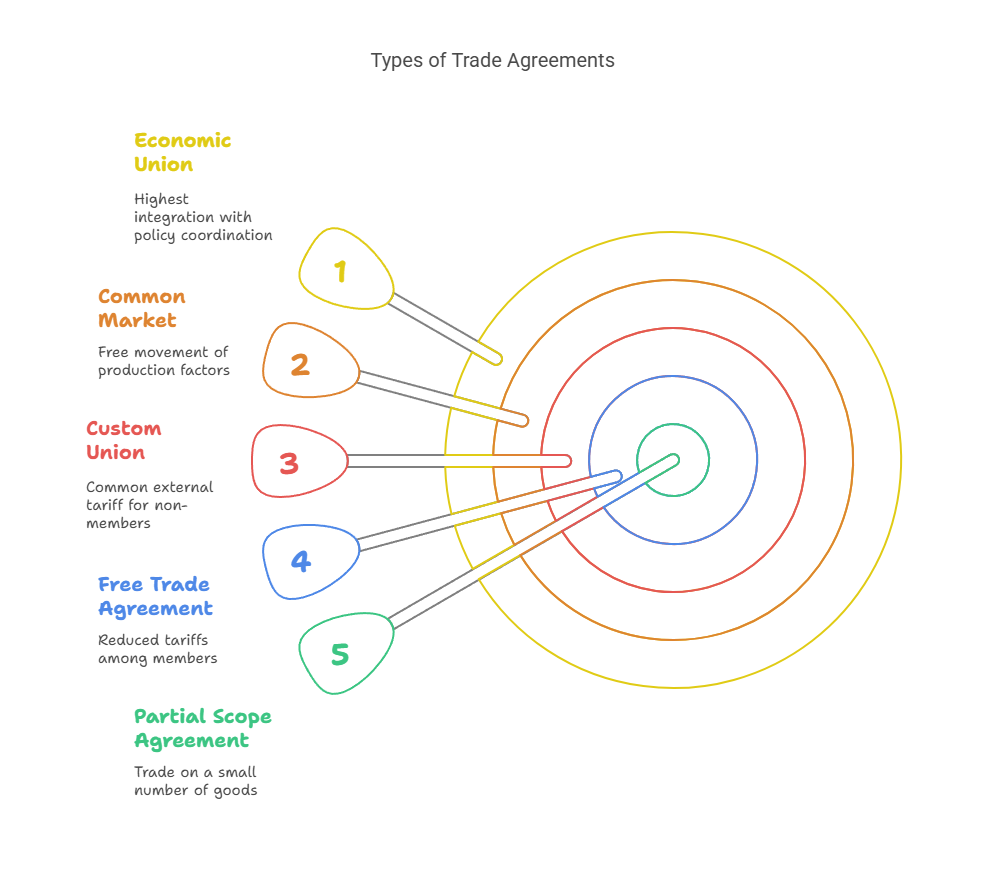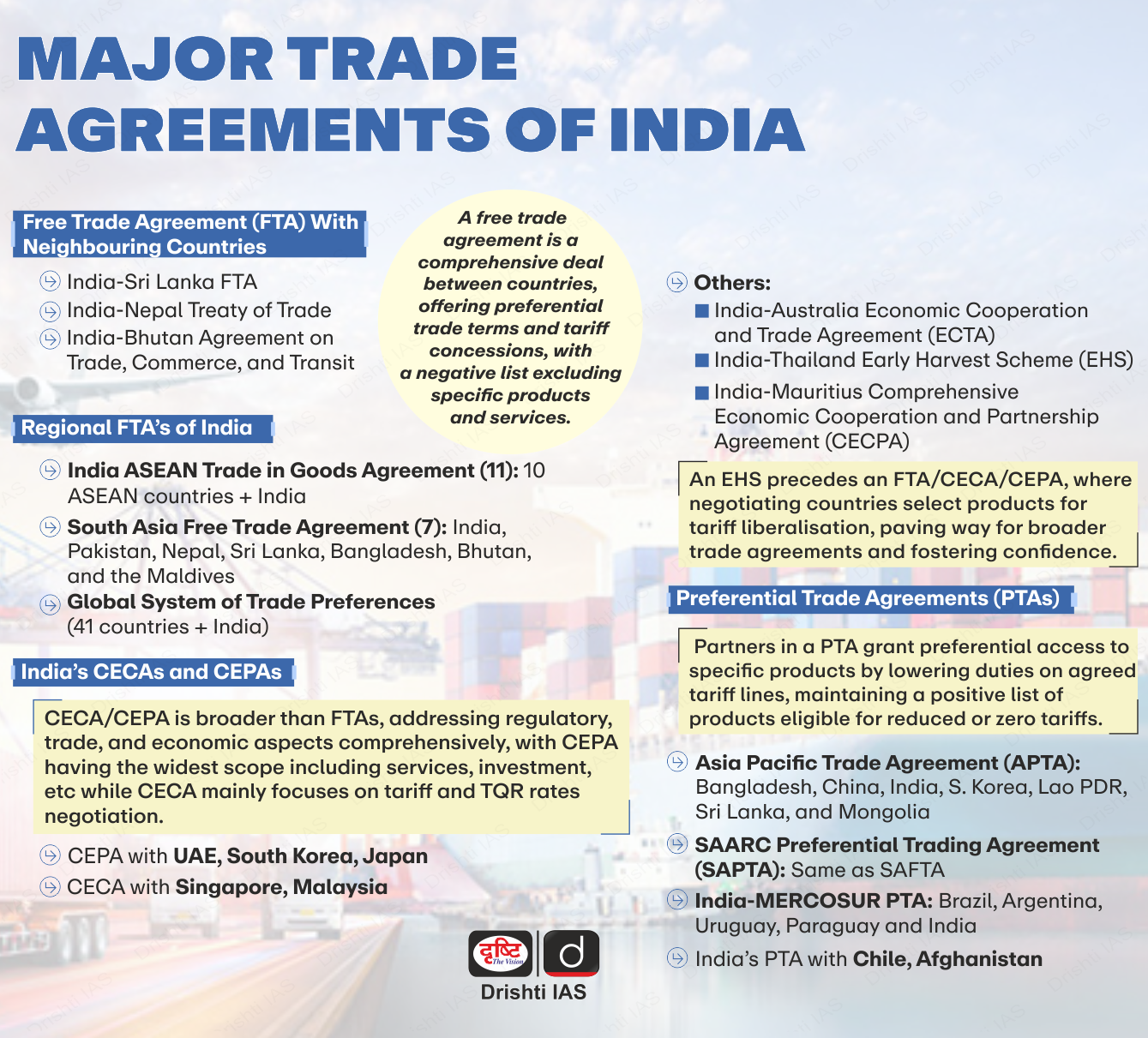Economy
India-UK Free Trade Agreement
- 07 May 2025
- 11 min read
For Prelims: India-UK Free Trade Agreement (FTA), FTA, China-plus One, RCEP, EFTA, Australia-India ECTA, Critical Minerals, India-Japan CEPA, UAE CEPA, ASEAN, Non-tariff Barriers, Rules of Origin, EU's Carbon Border Adjustment, Production-Linked Incentive (PLI) Scheme, MSME.
For Mains: Benefits of free trade agreements for India, key issues related to India's FTAs
Why in News?
India and the UK have signed a India-UK Free Trade Agreement (FTA), marking a significant step between the world's 5th and 6th largest economies amid ongoing global trade volatility and tariff uncertainties.
What are Key Highlights of the India-UK FTA?
- About India-UK Trade: UK is India’s 4th largest export destination and India is UK’s 11th largest trading partner. The bilateral trade of about USD 60 billion is projected to double by 2030.
- It is India’s 16th FTA, and the UK's most significant bilateral trade deal post-Brexit.
- The FTA grants zero-duty access for 99% of Indian exports to the UK, including textiles, apparel, leather, footwear, marine products, sports goods, toys, gems and jewellery, auto parts, engineering goods, and organic chemicals.
- Automobiles tariffs cut to 10% under a quota, down from over 100%
- It also promotes labour mobility. About 100 additional annual visas for Indian professionals, particularly in IT and healthcare
- Double Contribution Convention Agreement: India and the UK also signed a Double Contribution Convention Agreement (also called a Social Security Agreement) as one of the key aspects of the deal.
- It will ensure that professionals in either country are not forced to pay national insurance or social security contributions in both countries.
What are Free Trade Agreements (FTAs)?
- About: An FTA is a trade pact between two or more nations that aims to reduce or eliminate customs duties and trade barriers on goods traded between them.
- FTAs, unlike Preferential Trade Agreements (PTAs), offer comprehensive tariff elimination on most goods, whereas PTAs provide only limited tariff concessions on select products.
- Objectives:
- Reduction in Customs duties: Typically, 90-95% of goods are subject to lower or zero tariffs.
- Reduction in Non-trade barriers: Aims to ease regulations that hinder trade.
- Promotion of Services and Investment: Relax norms for services exports and encourage bilateral investments.
- Types of Trade Agreements:
What is the Significance of FTAs for India?
- Enhanced Market Access: FTAs enable Indian exporters to tap into new markets with preferential terms, boosting trade volumes and competitiveness.
- India's FTA with UAE boosted exports by 11.8% to USD 31.3 billion in FY23, offering preferential access to 97% of UAE's tariff lines, especially for textiles, gems, jewelry, and engineering goods.
- Investment Inflows: By fostering investor confidence and offering regulatory certainty, FTAs facilitate sustained foreign direct investment into India.
- For example, the EFTA agreement promises USD 100 billion in investments over 15 years, supporting Make in India and job creation.
- Supply Chain Resilience: FTAs help India diversify sourcing channels and secure vital inputs for strategic sectors.
- For example, FTAs like Australia-India ECTA help diversify supply chains, with access to critical minerals for green tech and EV manufacturing, strengthening India's position in global supply chains.
- Technology Access and Innovation: Through deeper economic integration, FTAs enable India to collaborate on advanced technologies and future-oriented sectors.
- For instance, India-Japan CEPA aids in bringing advanced manufacturing technologies, while the EFTA includes provisions for green tech and digital innovation cooperation.
- Services Sector Growth and Professional Mobility: FTAs open up new opportunities for Indian professionals and service providers through liberalised entry norms and mutual recognition.
- For instance, the UAE CEPA and Australia ECTA improve access for Indian services, with easier visa access for professionals and provisions for IT/ITeS sector growth.
What are the Key Concerns Associated with India's FTAs?
- Rising Trade Deficits: FTAs have often led to higher import growth than exports, raising concerns about long-term economic viability.
- From 2017-2022, exports to FTA partners grew by 31%, while imports surged by 82%, creating an unsustainable trade imbalance.
- Low FTA Utilization: India’s FTA utilization rate stands at 25%, far below the 70-80% seen in developed countries, indicating a failure to fully capitalize on FTA benefits.
- The slow pace of FTA talks with the EU and Canada leads to missed trade opportunities, hindering India's growth and competitiveness.
- Competitiveness Challenges: India faces stiff competition from partner countries in key industries due to innovation and cost advantages.
- E.g., ASEAN and South Korea have outpaced India in industries like electronics and textiles, due to superior innovation and cost efficiencies.
- India also faces an inverted duty structure, where raw material imports incur higher taxes than finished goods.
- E.g., ASEAN and South Korea have outpaced India in industries like electronics and textiles, due to superior innovation and cost efficiencies.
- Non-Tariff Barriers: While tariffs have decreased, non-tariff barriers (such as standards and technical measures) continue to hinder India’s export access.
- The EU's Carbon Border Adjustment could impact USD 8 billion worth of Indian exports, while labor standards may affect sectors like textiles and leather further exacerbating the issue.
- Complex Certification: The certification and rules of origin requirements under FTAs have raised compliance costs for exporters.
- IPR Tensions: FTAs with Western partners often pressure India to adopt stricter IPR regimes.
- For instance, FTAs with EU/UK/US create conflicts with India's domestic policies, especially over pharmaceutical patents and data exclusivity, affecting the generic drug industry.
How can India Enhance the Effectiveness of its FTAs?
- Integrated Policy Approach: India's Production-Linked Incentive (PLI) scheme to boost manufacturing should be strategically aligned with future FTAs to ensure that PLI-supported sectors receive preferential treatment in trade agreements.
- Value Chain Integration: India should create specialized industrial parks, establish supplier development programs with major partner companies, and launch sector-specific skill development initiatives aligned with value chain needs.
- MSME Integration Strategy: Set up MSME export centers with FTA-specific support, launch an "MSME Global Connect" program, and offer credit schemes with performance incentives.
- Targeted FTA Negotiation Strategy: Adopt a targeted FTA negotiation strategy with clear market access thresholds based on industry readiness and a permanent multi-stakeholder team for negotiations.
- Boosting R&D and Prioritise Services: Boosting R&D in Export-Oriented Industries to create high-value products that align with global demand.
- India should prioritize greater market access for its strong services sectors—especially IT, BPO, and other knowledge-based services—while designing future FTAs.
- Re-negotiatingExisting FTAs: India should renegotiate existing FTAs to promote diversification into high-tech and value-added products such as chemicals, automotive components, and electrical apparatus.
Conclusion
The India-UK FTA represents a significant step in enhancing bilateral trade, investment, and market access. While it holds immense potential for economic growth, challenges like trade imbalances, low utilization, and non-tariff barriers need to be addressed. A strategic approach, integrating domestic policies and strengthening stakeholder engagement, is crucial for maximizing the benefits of FTAs.
|
Drishti Mains Question: Critically evaluate the impact of Free Trade Agreements on India’s trade balance and industrial competitiveness. |
UPSC Civil Services Examination, Previous Year Questions (PYQs)
Prelims
Q. Consider the following countries: (2018)
- Australia
- Canada
- China
- India
- Japan
- USA
Which of the above are among the ‘free-trade partners’ of ASEAN?
(a) 1, 2, 4 and 5
(b) 3, 4, 5 and 6
(c) 1, 3, 4 and 5
(d) 2, 3, 4 and 6
Ans: (c)
Q. The term ‘Regional Comprehensive Economic Partnership’ often appears in the news in the context of the affairs of a group of countries known as(2016)
(a) G20
(b) ASEAN
(c) SCO
(d) SAARC
Ans: (b)
Mains
Q. How would the recent phenomena of protectionism and currency manipulations in world trade affect macroeconomic stability of India? (2018)
Q. Evaluate the economic and strategic dimensions of India’s Look East Policy in the context of the post Cold War international scenario. (2016)








